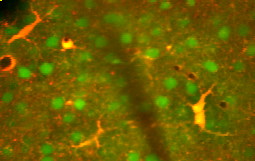Astrocyte
Astrocytes are a type of glial cell that are found in the brain and spinal cord. They are the most abundant cell types in the human brain, playing a critical role in the maintenance of the central nervous system (CNS). Astrocytes are star-shaped cells, a characteristic that gives them their name, derived from the Greek words "astron" meaning star and "kytos" meaning cell.
Functions
Astrocytes perform a wide range of functions essential for the proper functioning of the CNS. These include:
- Support and Bracing: Astrocytes provide structural support to neurons, helping to hold them in place.
- Blood-Brain Barrier Maintenance: They are involved in the formation and maintenance of the blood-brain barrier, a selective barrier that prevents certain substances from passing from the blood into the brain.
- Nutrient and Ion Regulation: Astrocytes regulate the concentration of ions and nutrients in the extracellular space, ensuring the optimal environment for neuronal function.
- Neurotransmitter Regulation: They play a role in the uptake and recycling of neurotransmitters, which are chemicals that transmit signals in the brain.
- Neurogenesis: Astrocytes are involved in the process of neurogenesis, the formation of new neurons in the brain.
- Synaptic Support: They are crucial for the formation, maintenance, and modulation of synapses, the points of communication between neurons.
Types of Astrocytes
Astrocytes can be broadly classified into two main types based on their location and function:
- Protoplasmic Astrocytes: Found in the gray matter of the brain, these astrocytes have numerous branching processes that make contact with blood vessels and neurons.
- Fibrous Astrocytes: Located in the white matter, fibrous astrocytes have fewer processes than protoplasmic astrocytes and are involved in providing structural support.
Pathology
Astrocytes are involved in various pathological conditions affecting the CNS. They can undergo changes in response to injury or disease, a process known as reactive gliosis. In conditions such as Alzheimer's disease, multiple sclerosis, and amyotrophic lateral sclerosis, astrocytes can either contribute to the pathology or play a protective role, depending on the context of the disease.
Research and Clinical Implications
Research into astrocytes has expanded our understanding of their roles in the CNS, revealing that they are not just supportive cells but are actively involved in the modulation of neuronal activity and plasticity. This has implications for the development of new therapeutic strategies for neurological disorders, where targeting astrocyte function could offer novel approaches to treatment.
Transform your life with W8MD's budget GLP-1 injections from $125.
W8MD offers a medical weight loss program to lose weight in Philadelphia. Our physician-supervised medical weight loss provides:
- Most insurances accepted or discounted self-pay rates. We will obtain insurance prior authorizations if needed.
- Generic GLP1 weight loss injections from $125 for the starting dose.
- Also offer prescription weight loss medications including Phentermine, Qsymia, Diethylpropion, Contrave etc.
NYC weight loss doctor appointments
Start your NYC weight loss journey today at our NYC medical weight loss and Philadelphia medical weight loss clinics.
- Call 718-946-5500 to lose weight in NYC or for medical weight loss in Philadelphia 215-676-2334.
- Tags:NYC medical weight loss, Philadelphia lose weight Zepbound NYC, Budget GLP1 weight loss injections, Wegovy Philadelphia, Wegovy NYC, Philadelphia medical weight loss, Brookly weight loss and Wegovy NYC
|
WikiMD's Wellness Encyclopedia |
| Let Food Be Thy Medicine Medicine Thy Food - Hippocrates |
Medical Disclaimer: WikiMD is not a substitute for professional medical advice. The information on WikiMD is provided as an information resource only, may be incorrect, outdated or misleading, and is not to be used or relied on for any diagnostic or treatment purposes. Please consult your health care provider before making any healthcare decisions or for guidance about a specific medical condition. WikiMD expressly disclaims responsibility, and shall have no liability, for any damages, loss, injury, or liability whatsoever suffered as a result of your reliance on the information contained in this site. By visiting this site you agree to the foregoing terms and conditions, which may from time to time be changed or supplemented by WikiMD. If you do not agree to the foregoing terms and conditions, you should not enter or use this site. See full disclaimer.
Credits:Most images are courtesy of Wikimedia commons, and templates, categories Wikipedia, licensed under CC BY SA or similar.
Contributors: Prab R. Tumpati, MD





